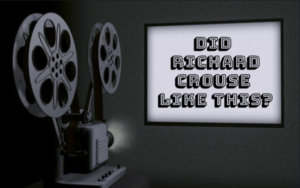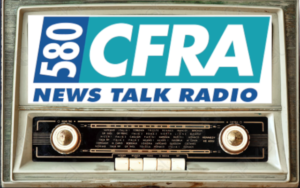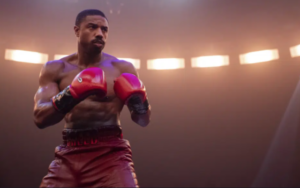NEWSTALK 1010: RICHARD ON Jonathan Majors’S arrest in New York
 I join CTV NewsChannel anchor Andrea Bain to have a look at some new movies released in theatres and talk about the career of Jonathan Majors.
I join CTV NewsChannel anchor Andrea Bain to have a look at some new movies released in theatres and talk about the career of Jonathan Majors.
Watch the whole thing HERE!
 I join CTV NewsChannel anchor Andrea Bain to have a look at some new movies released in theatres and talk about the career of Jonathan Majors.
I join CTV NewsChannel anchor Andrea Bain to have a look at some new movies released in theatres and talk about the career of Jonathan Majors.
Watch the whole thing HERE!
 I appear on “CTV News at 6” with anchor Andria Case to talk about the best movies and television to watch this weekend. This week I have a look at “Creed III,” the ninth movie in the “Rocky” franchise, the big screen debut of DCI Luther in “Luther: the Fallen Sun” and the family drama “Juniper.”
I appear on “CTV News at 6” with anchor Andria Case to talk about the best movies and television to watch this weekend. This week I have a look at “Creed III,” the ninth movie in the “Rocky” franchise, the big screen debut of DCI Luther in “Luther: the Fallen Sun” and the family drama “Juniper.”
Watch the whole thing HERE! (Starts at 36:14)
 I join NewsTalk 1010 host Jim Richards on the coast-to-coast-to-coast late night “NewsTalk Tonight” to play the game “Did Richard Crouse Like This?” This week we talk about “Creed III,” the latest from the “Rocky” universe, the adventures of London copper “Luther: The Fallen Sun” and the family drama “Juniper.”
I join NewsTalk 1010 host Jim Richards on the coast-to-coast-to-coast late night “NewsTalk Tonight” to play the game “Did Richard Crouse Like This?” This week we talk about “Creed III,” the latest from the “Rocky” universe, the adventures of London copper “Luther: The Fallen Sun” and the family drama “Juniper.”
Listen to the whole thing HERE!
 I joined CP24 to have a look at new movies coming to VOD, streaming services and theatres. Today we talk about “Creed III,” the latest from the “Rocky” universe, the adventures of London copper “Luther: The Fallen Sun” and the family drama “Juniper.”
I joined CP24 to have a look at new movies coming to VOD, streaming services and theatres. Today we talk about “Creed III,” the latest from the “Rocky” universe, the adventures of London copper “Luther: The Fallen Sun” and the family drama “Juniper.”
Watch the whole thing HERE!
 I join CTV NewsChannel anchor Marcia MacMillan to talk about “Creed III,” the latest from the “Rocky” universe, the adventures of London copper “Luther: The Fallen Sun” and the family drama “Juniper.”
I join CTV NewsChannel anchor Marcia MacMillan to talk about “Creed III,” the latest from the “Rocky” universe, the adventures of London copper “Luther: The Fallen Sun” and the family drama “Juniper.”
Watch the whole thing HERE!
 I sit in on the CFRA Ottawa morning show with host Bill Carroll to talk the new movies coming to theatres including “Creed III,” the latest from the “Rocky” universe, the adventures of London copper “Luther: The Fallen Sun” and the family drama “Juniper.”
I sit in on the CFRA Ottawa morning show with host Bill Carroll to talk the new movies coming to theatres including “Creed III,” the latest from the “Rocky” universe, the adventures of London copper “Luther: The Fallen Sun” and the family drama “Juniper.”
Listen to the whole thing HERE!
 Watch as I review three movies in less time than it takes to lock the door! Have a look as I race against the clock to tell you about Creed III,” the latest from the “Rocky” universe, the adventures of London copper “Luther: The Fallen Sun” and the family drama “Juniper.”
Watch as I review three movies in less time than it takes to lock the door! Have a look as I race against the clock to tell you about Creed III,” the latest from the “Rocky” universe, the adventures of London copper “Luther: The Fallen Sun” and the family drama “Juniper.”
Watch the whole thing HERE!
 Can “Creed III,” the new Michael B. Jordan film now playing in theatres, really be part of the “Rocky” franchise when it doesn’t feature either Rocky Balboa or even a hint of “Gonna Fly Now,” the original movie’s inspirational theme song?
Can “Creed III,” the new Michael B. Jordan film now playing in theatres, really be part of the “Rocky” franchise when it doesn’t feature either Rocky Balboa or even a hint of “Gonna Fly Now,” the original movie’s inspirational theme song?
The answer is a resounding yes. Technically the ninth movie in the series, “Creed III” finds fresh ways to echo the original while doing its own fancy footwork.
“Creed III” begins with a flashback. It’s the early 2000s and fifteen-year-old Creed (Thaddeus J. Mixson) is running with Damian “Dame” Anderson (Spence Moore II), an older guy from his group home. With a lethal right hook Dame is headed for the boxing big time; the nationals, the Olympics and then, maybe, a world championship. “You’ll be with me,” he tells young Creed. “Someone has to carry my bags.”
When things get violent one night in front of a liquor store, Creed runs to safety but Dame goes to jail.
Cut to present day.
In “Creed II” Adonis, (Jordan who also directs this time out), finally stepped away from the long shadow cast by his father Apollo Creed and mentor Rocky Balboa to become his own man. Retired—“I left Boxing,” he says. “Boxing didn’t leave me.”—his career and family life in order, he’s now a celebrity gym owner and boxing promoter.
“I spent the last seven years of my life living out my wildest dreams,” says Adonis. “Rocky. My dad. This is built on their shoulders.”
Adonis moved on, but Dame (Jonathan Majors), fresh out of jail, is mired in the past. The former prodigy boxer wants his shot at a title, at the life Creed has, and he wants to fight Creed to get it.
“You think you mad?” he asks Adonis. “Try spending half your life in a cell. Watching somebody else live your life.”
“Creed III” isn’t really a sports movie. Blows are exchanged, and there’s even a lo-fi training montage—instead of Rocky’s famous run on the 72 stone steps leading up to the entrance of the Philadelphia Museum of Art, Creed bolts up the Hollywood Hills—but this is more about the trauma of the past revisited in the present, than the action in the ring.
Like the other movies in the “Rocky”/”Creed” Universe, “III” is about family. Creed’s mother (Phylicia Rashad), wife Bianca (Tessa Thompson) and daughter Amara (Mila Davis-Kent) provide family dynamics at home, but it is the bond between Creed and Dame, once as close as brothers, that provides the movie’s core relationship.
The two friends, separated by dreams, jail and success, are forever bound by memories and the shared stories of trauma. The difference between them is that Creed has managed his life with control and timing, while Dane is about rage and revenge. Their mano-et-mano showdown may ultimately unfold in slightly predictable ways by the film’s twelfth round, but Jordan and Majors are anything but obvious.
Jordan delivers the goods as Creed, but it is Majors who steals the show. Dame is a complex character, one cursed to feel left behind. “I was the best but I never got a chance to show that,” he says, his voice dripping with anger. Majors makes us feel empathy for an intimidating guy who doesn’t play by the rules, by showing both his steeliness and vulnerability.
“Creed III,” of course, leads up to a showdown between the two frenemies, but as a director Jordan finds a way to make the inevitable fight more personal, more dynamic than the usual boxing movie finale. It’s a knockout climax to a sometimes formulaic, but heartfelt, story of ambition and regret.
 I appear on “CTV News at 6” with anchor Andria Case to talk about the best movies and television to watch this weekend. This week I have a look at the 11th Toronto Black Film Festival, the Marvel movie “Ant-Man and the Wasp: Quantumania” and Liam Neeson as a famous detective in “Marlowe.”
I appear on “CTV News at 6” with anchor Andria Case to talk about the best movies and television to watch this weekend. This week I have a look at the 11th Toronto Black Film Festival, the Marvel movie “Ant-Man and the Wasp: Quantumania” and Liam Neeson as a famous detective in “Marlowe.”
Watch the whole thing HERE! (Starts at 37:21)